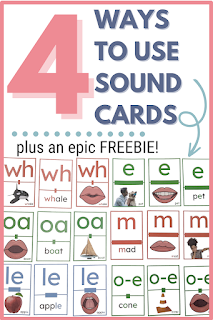Did you know the English alphabet has 26 letters, 44 sounds, and 150 different spellings? Yes, you read that right, 150 DIFFERENT SPELLINGS! Teaching students all these sound-spellings may seem overwhelming, but it doesn't have to be. Using sound cards in your reading instruction is essential to help students commit these sound-spellings to memory and become more fluent and automatic readers! Keep reading to grab over 300 free sound cards.
What are Sound Cards?
Sound Cards visually represent a particular sound, including a sample word and power bar. The power bar shows how common the spelling of each sound is. The longer the bar, the more common the spelling.
There are three types of sound cards:
- sound spellings only
- visual cues
- articulation prompts
Why are Sound Cards Important?
It is important to explicitly teach these sound-symbol relationships to be able to read and spell correctly. The power bar helps students understand how common the spelling is.
Reviewing the sounds before the lesson helps activate prior knowledge and solidify orthographic mapping. Orthographic mapping is the mental process of permanently storing words for immediate retrieval and becoming fluent readers.
How to Use Sound Cards
There are so many ways to use sound cards. Here are some of my favorites:
Sound Cards As Guided Practice
The sound cards with articulation prompts give students a model of what their mouths should look like when making each sound. This is important when introducing the sound for the first time and if students need to pronounce a sound correctly. I can't take any credit for this awesome setup pictures below; it is the amazing speech therapist at my school.
Sound Cards As a Warm Up
I have the Sound Cards cut up and organized by skill. We start every reading group by reviewing the sounds. To spice it up, each day, we review the sounds differently. Some ways are:
- Each student has their own pile that they review the sounds individually.
- I have the pile, and the students say the sounds chorally.
- I have the pile, and the students take turns saying the sounds
- As students become more automatic, I may take out the sound cards with visual prompts.
- Review digitally (available with Syllable Type Lessons)
Sound Cards As a Display
I have all of the sound cards displayed on my wall. These serve as a quick reference during lessons when discussing sounds with multiple spellings when reading and writing.
Sound Cards As Discussion Prompts
The power bars on each sound card are a great way to get students thinking about sound's spellings. I love to simply ask, "What do you notice?"
This allows students to make their own observations about how common or uncommon the spellings are. We also talk about the position of vowel sounds in a word. For example, students may notice that /ai/ is often found in the middle of a word/syllable while /ay/ is typically at the end.
Where To Get Sound Cards
Now that you have some ideas for using sound cards, you may be wondering where to find them. Getting over 300 sound cards organized by skill is just a click away!
I hope you enjoy these free sound cards! Let me know in the comments how else you use them with your students!
Pin for later:







